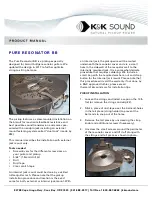Summary of Contents for FlexStation II
Page 6: ...FlexStation II Operator s Manual Rev D vi ...
Page 92: ...4 Applications 86 FlexStation II Operator s Manual Rev D ...
Page 102: ...5 Service and Maintenance Procedures 96 FlexStation II Operator s Manual Rev D ...
Page 124: ...6 Troubleshooting Procedures 118 FlexStation II Operator s Manual Rev D ...
Page 134: ...7 Appendices 128 FlexStation II Operator s Manual Rev D ...



































